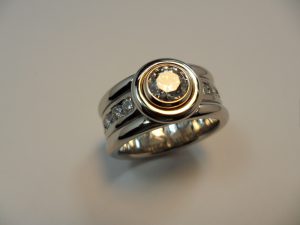A surge in palladium prices to exceed platinum, poses a marketing challenge for jewellery in both precious metals. Palladium prices equalled platinum on September 27 for the first time in 16 years, and palladium prices were higher than platinum this week. Gold has a premium over both metals. On October 11, 2017, platinum was up 0.2 percent at USD$930.50 an ounce, while palladium was up 0.3 percent at USD$936.25 an ounce.
The new price dynamics make it harder to promote platinum as the premier jewellery metal, with Platinum Guild having shrunk its marketing drive in Europe in recent years. However, it is becoming relatively cheap for jewellers to restock platinum compared with gold. Designer-makers say platinum is a superior metal in qualitative terms to palladium, a lustrous silvery-white rare metal used in a diverse range of applications.

Palladium was the best-performing precious metal last year, rising 20 percent in price for its biggest annual gain in six years. Platinum ended 2016 only 1 percent higher. Palladium has rallied due to a widely held perception that the metal is in a global deficit amid speculation that production won’t be enough to meet demand. Palladium’s surge has been driven by strong industrial demand for its application in catalytic converters that clean exhaust fumes – chiefly of petrol-powered vehicles. The main use of palladium is in industry, while jewellery accounts for a modest share of total demand for the metal.
Platinum has the opposite story, as demand by industry, notably in catalytic converters for diesel cars, is struggling as diesel falls out of fashion as a vehicle fuel. Again platinum’s application in jewellery is a modest segment of its use, which is mainly industrial. The prices of both palladium and platinum are driven far more by industry requirements and investor demand, than by consumption in jewellery. This has led to a scenario where palladium and platinum prices are now roughly level pegging.
Investors say the relative price outlook for both metals will likely be a bumpy road as palladium faces resistance as it nudges above platinum. Any sustained surge in the price of palladium above platinum would create a whole new set of challenges to platinum marketers already struggling to get across a message that platinum is the No. 1 jewellery metal.
While platinum has been seen as the metal of choice for engagement rings, palladium is perhaps best known for its use in men’s wedding bands. Palladium is popular in wedding bands for men because it is lighter and was for many years more affordable than platinum, and it has the advantage over costlier white gold of not requiring any coating. Luxury jewellers such as Stephen Webster and Vivienne Westwood have included palladium pieces in their collections. Jewellers believe it is going to be hard to see sustained demand for palladium wedding bands if the price remains around the platinum mark.
Simon Johnson, Chairman of the National Association of Jewellers (NAJ), has said platinum is still generally seen by the public as the premium choice, in terms of weight, purity and rarity. If the palladium price remains where it is, there is a danger that public demand for palladium will start to drop off, he has said. Palladium has struggled with a consistent preference for gold and platinum in jewellery in much of the world. Many jewellery consumers simply have not heard of palladium due to a lack of high-profile marketing campaigns, so it will be an uphill task for jewellers to persuade them to spend even more on a metal that they are not familiar with.
However, palladium is far from knocked out as a jewellery metal. It requires a highly creative approach from marketers, who need to sell its emotional value at a time of high prices.

